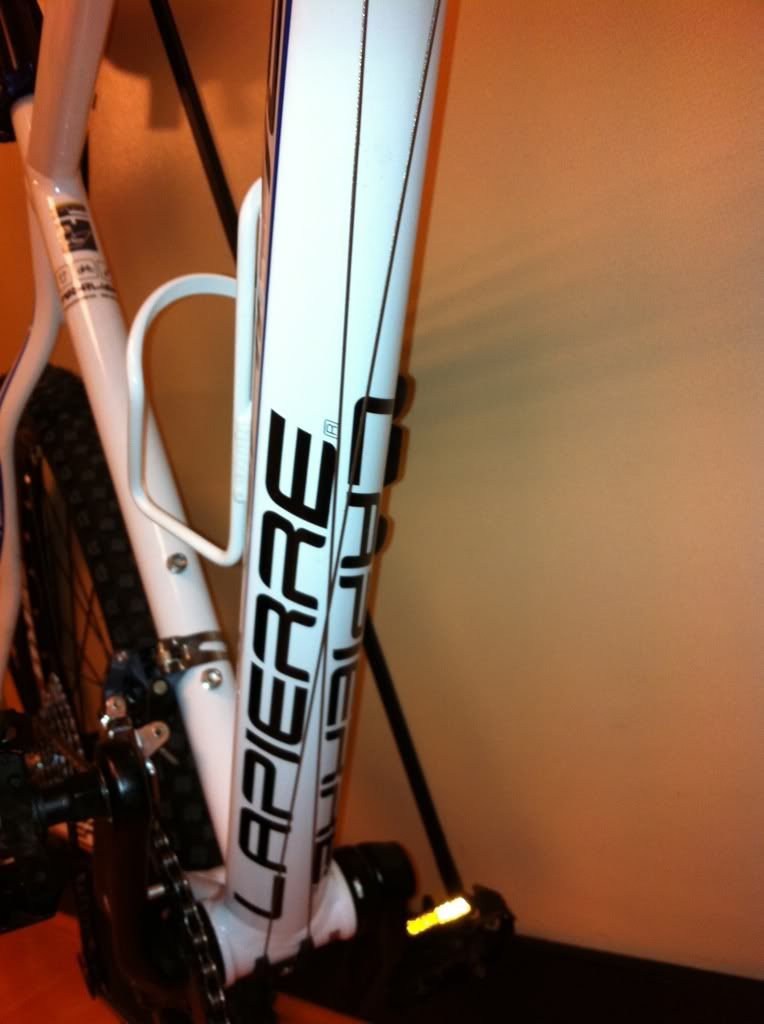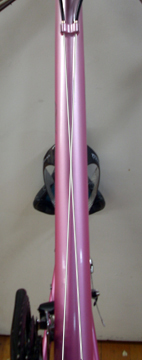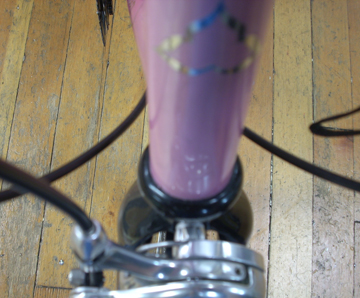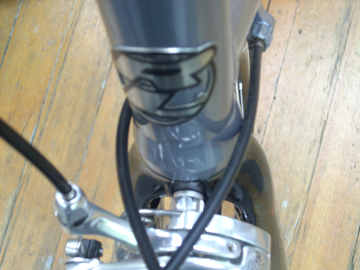Estás usando un navegador obsoleto. No se pueden mostrar este u otros sitios web correctamente.
Se debe actualizar o usar un navegador alternativo.
Se debe actualizar o usar un navegador alternativo.
El hilo de MTB/BTT
- Autor Pelanes
- Fecha de inicio
- Mensajes
- 22.821
- Reacciones
- 7.346
Respuesta: El hilo de MTB/BTT
Gracias a todos por vuestros consejos
A todo esto... Lleváis pedales automáticos?
Gracias a todos por vuestros consejos

A todo esto... Lleváis pedales automáticos?
Manu1001
Au revoire.
- Mensajes
- 76.882
- Reacciones
- 20.707
Respuesta: El hilo de MTB/BTT
Si, por supuesto. Pero mentalízate de que te vas a pegar unas cuantas ostias al principio. Es ley de vida. Por ahí tengo los Shimano XT que venían con mi bici, y que cambié por los Crank Brothers. Te los vendo baratos...
Manu1oo1
Si, por supuesto. Pero mentalízate de que te vas a pegar unas cuantas ostias al principio. Es ley de vida. Por ahí tengo los Shimano XT que venían con mi bici, y que cambié por los Crank Brothers. Te los vendo baratos...

Manu1oo1
Max Renn
Miembro habitual
- Mensajes
- 6.690
- Reacciones
- 1.567
Respuesta: El hilo de MTB/BTT
Los pedales automáticos son imprescindibles cuando te acostumbras. Ya no podrás ir sin ellos.
Al principio te vas a dar alguna hostia casi seguro porque vas a tratar de sacar el pie y no podrás. Pasado un tiempecito, el gesto de desenganche te saldrá de forma natural y no tendrás mayor problema. De momento regúlatelos flojitos para sacar el pie con facilidad. Luego, cuando tengas más práctica, ya te los podrás poner más duros.
El pedal automático te da sensación de ir "pegado" a la bicicleta, el pedaleo es más redondo y transmites más fuerza a los pedales. Al comienzo te sentirás muy inseguro, pero con el tiempo verás que tiene muchos beneficios.
El otro día me di un hostión yendo casi parado. Estaba subiendo por una zona técnica, llena de piedras, y tracé mal, resbalándome la rueda y cayéndome sin tener tiempo de desengancharme de los pedales.
Los pedales automáticos son imprescindibles cuando te acostumbras. Ya no podrás ir sin ellos.
Al principio te vas a dar alguna hostia casi seguro porque vas a tratar de sacar el pie y no podrás. Pasado un tiempecito, el gesto de desenganche te saldrá de forma natural y no tendrás mayor problema. De momento regúlatelos flojitos para sacar el pie con facilidad. Luego, cuando tengas más práctica, ya te los podrás poner más duros.
El pedal automático te da sensación de ir "pegado" a la bicicleta, el pedaleo es más redondo y transmites más fuerza a los pedales. Al comienzo te sentirás muy inseguro, pero con el tiempo verás que tiene muchos beneficios.
El otro día me di un hostión yendo casi parado. Estaba subiendo por una zona técnica, llena de piedras, y tracé mal, resbalándome la rueda y cayéndome sin tener tiempo de desengancharme de los pedales.
- Mensajes
- 22.821
- Reacciones
- 7.346
Respuesta: El hilo de MTB/BTT
Lo que tu no vendas...
Cuales son? Igual me interesan, aunque no de inmediato. Con calas?
Si, por supuesto. Pero mentalízate de que te vas a pegar unas cuantas ostias al principio. Es ley de vida. Por ahí tengo los Shimano XT que venían con mi bici, y que cambié por los Crank Brothers. Te los vendo baratos...
Manu1oo1
Lo que tu no vendas...

Cuales son? Igual me interesan, aunque no de inmediato. Con calas?
LoJaume
Desafinando
Respuesta: El hilo de MTB/BTT
Amén.
Sobre la transmisión, aparte de engrasar la cadena, vale la pena que se compre un medidor de cadena -cuesta unos 5 euros- que te indicará cuándo debes cambiarla.
La cadena con el tiempo se alarga, y a partir de cierto momento empieza a joder los platos y piñones, componentes éstos mucho más caros.
Una cadena dura 1000 a 3000 km y cuesta 20 euros. SI la cambias cuando toca, el resto de transmisión te durará muchísimo más.
Eso si, por mucho que tu tendero te prometa, vete empapando de mecánica de la bici, sobre todo en lo referente a mantenimiento y demás. Una bici bien cuidada y ajustada te puede durar muchos años sin darte un solo problema.
Amén.
Sobre la transmisión, aparte de engrasar la cadena, vale la pena que se compre un medidor de cadena -cuesta unos 5 euros- que te indicará cuándo debes cambiarla.
La cadena con el tiempo se alarga, y a partir de cierto momento empieza a joder los platos y piñones, componentes éstos mucho más caros.
Una cadena dura 1000 a 3000 km y cuesta 20 euros. SI la cambias cuando toca, el resto de transmisión te durará muchísimo más.
LoJaume
Desafinando
Respuesta: El hilo de MTB/BTT
Por supuesto. Todo son ventajas.
Cómprale los XT al Manu, que seguro que no los ha usao nunca.
A todo esto... Lleváis pedales automáticos?
Por supuesto. Todo son ventajas.
Cómprale los XT al Manu, que seguro que no los ha usao nunca.

diazign
Siamese Dream
Respuesta: El hilo de MTB/BTT
Yo sigo muy contento con mi Cube
Aunque Franciscus ya tiene la suya, decir que los nuevos modelos son muy bonitos, y además de en CRC la venden en una tienda alemana que es...
[url]http://mhw-bike-house.de/shop/show/show_kat/Fahrraeder-und-Bikes/2011er-Modelle/Cube/Hardtail.htm[/URL]
Ahí fue donde la compré yo y también muchos de foromtb, y hasta donde sé nadie tuvo problema alguno. Incluso me enviaron una potencia nueva a casa porque el fabricante -Easton- estaba sustituyendo algunas por defecto de fabricación, y la mía era de ese periodo de tiempo.
Lo curioso es que ponían un precio en la web, normalmente más barato que en CRC y que en tienda física, pero si les escribías un mail pidiendo precio final con envío a España siempre te la dejaban más barata que lo que ofertaban en su web.
De todas formas yo también prefería tienda física, pero el distribuidor de Cube en España no traía tallas mayores de la 20, así que me vi forzado a pedirla fuera. Me costó unos 250€ más barata que en CRC, y unos 300 más barata que aquí.
Saludos.
Osti, hoy he visto una tienda de Cube, en Lleida, y son realmente guapas y bien hechas. Es para pensárselo, eh?
También las venden en CRC.
Yo sigo muy contento con mi Cube

Aunque Franciscus ya tiene la suya, decir que los nuevos modelos son muy bonitos, y además de en CRC la venden en una tienda alemana que es...
[url]http://mhw-bike-house.de/shop/show/show_kat/Fahrraeder-und-Bikes/2011er-Modelle/Cube/Hardtail.htm[/URL]
Ahí fue donde la compré yo y también muchos de foromtb, y hasta donde sé nadie tuvo problema alguno. Incluso me enviaron una potencia nueva a casa porque el fabricante -Easton- estaba sustituyendo algunas por defecto de fabricación, y la mía era de ese periodo de tiempo.
Lo curioso es que ponían un precio en la web, normalmente más barato que en CRC y que en tienda física, pero si les escribías un mail pidiendo precio final con envío a España siempre te la dejaban más barata que lo que ofertaban en su web.
De todas formas yo también prefería tienda física, pero el distribuidor de Cube en España no traía tallas mayores de la 20, así que me vi forzado a pedirla fuera. Me costó unos 250€ más barata que en CRC, y unos 300 más barata que aquí.
Saludos.
Manu1001
Au revoire.
- Mensajes
- 76.882
- Reacciones
- 20.707
Respuesta: El hilo de MTB/BTT
Pues eso, unos Shimano XT. Es decir, los que hay justo por debajo de su tope de gama. Las calas, debería tenerlas, pero tengo que buscarlas. Mañana te digo algo.
Manu1oo1
Cuales son? Igual me interesan, aunque no de inmediato. Con calas?
Pues eso, unos Shimano XT. Es decir, los que hay justo por debajo de su tope de gama. Las calas, debería tenerlas, pero tengo que buscarlas. Mañana te digo algo.
Manu1oo1
- Mensajes
- 22.821
- Reacciones
- 7.346
Respuesta: El hilo de MTB/BTT
No sé cómo será el cuentakm que me pongan (me han dicho que un Cateye con cabe) pero por si acaso: cuál es el cuentakm wireless BBB que todo globero debiera tener?
No sé cómo será el cuentakm que me pongan (me han dicho que un Cateye con cabe) pero por si acaso: cuál es el cuentakm wireless BBB que todo globero debiera tener?
diazign
Siamese Dream
Respuesta: El hilo de MTB/BTT
Yo tengo el modelo más sencillo de Polar con sensor de ritmo cardiaco; el CS100. Existe también el CS100B, algo más barato, ya que viene sin el transmisor; para el que ya lo tenga de otro Polar.
http://lacasadelciclista.com/product_info.php/cPath/37/products_id/183
Ahí fue donde lo encontré con mejor precio. Por ahora estoy contento con él.
Saludos.
Yo tengo el modelo más sencillo de Polar con sensor de ritmo cardiaco; el CS100. Existe también el CS100B, algo más barato, ya que viene sin el transmisor; para el que ya lo tenga de otro Polar.
http://lacasadelciclista.com/product_info.php/cPath/37/products_id/183
Ahí fue donde lo encontré con mejor precio. Por ahora estoy contento con él.
Saludos.
Respuesta: El hilo de MTB/BTT
llego tarde pero bueno.... Felicidades es una muy buena compra.
yo tengo una Lapierre xcontrol 210 y estoy super contento, no me ha dado ningún problema y va para tres años ya. Y eso que yo de mantenimiento cero patatero.
yo no soy muy pijoteras en estas cosas por lo que lo único que le he cambiado ha sido el asiento
Pues efectivamente, tras un duro mano a mano con la Cannondale SL2, la Lapierre se viene con papá
Mañana me la entregan...
---
- Enviado usando Tapatalk
llego tarde pero bueno.... Felicidades es una muy buena compra.
yo tengo una Lapierre xcontrol 210 y estoy super contento, no me ha dado ningún problema y va para tres años ya. Y eso que yo de mantenimiento cero patatero.
yo no soy muy pijoteras en estas cosas por lo que lo único que le he cambiado ha sido el asiento
- Mensajes
- 22.821
- Reacciones
- 7.346
Respuesta: El hilo de MTB/BTT
Bueno, es un Cateye Velo 5. No está nada mal.
Primeras impresiones tras 4 Km carril-bici:







Lamadrededios cómo ha avanzado la tecnología. Subo mejor con plato medio y piñón medio que con la vieja Conor con plato pequeño y piñón grande.
Lo del cambio es alucinante (para mí, comparado con mi viejo shimano 100GS) Cómo se puede cambiar tan preciso, rápido y suave, y eso quedicen que SRAM es brusco. Cómo será un XT
Lo de llevar suspensión en la horquilla también es otro mundo. A ver cuándo la saco al monte
Hablando de asientos... el vaquero destiñe de azul en el sillín blanco
Una fotico:

Bueno, es un Cateye Velo 5. No está nada mal.
Primeras impresiones tras 4 Km carril-bici:







Lamadrededios cómo ha avanzado la tecnología. Subo mejor con plato medio y piñón medio que con la vieja Conor con plato pequeño y piñón grande.
Lo del cambio es alucinante (para mí, comparado con mi viejo shimano 100GS) Cómo se puede cambiar tan preciso, rápido y suave, y eso quedicen que SRAM es brusco. Cómo será un XT

Lo de llevar suspensión en la horquilla también es otro mundo. A ver cuándo la saco al monte
Hablando de asientos... el vaquero destiñe de azul en el sillín blanco

Una fotico:

- Mensajes
- 22.821
- Reacciones
- 7.346
Respuesta: El hilo de MTB/BTT
Me acabo de dar cuenta de una cosa: los cables del cambio se cruzan por debajo del tubo:

Una rápida búsqueda por google me dice que no es algo que tenga importancia, pero a mí me mosquea Qué os parece?
Qué os parece?
Edito: parece ser que no es infrecuente, y algunas marcas lo usan para hacer que el recorrido de los cables sea más suave y natural.
A mí me parecía una chapuza de la tienda pero parece ser que no
Me acabo de dar cuenta de una cosa: los cables del cambio se cruzan por debajo del tubo:

Una rápida búsqueda por google me dice que no es algo que tenga importancia, pero a mí me mosquea
 Qué os parece?
Qué os parece?Edito: parece ser que no es infrecuente, y algunas marcas lo usan para hacer que el recorrido de los cables sea más suave y natural.
A mí me parecía una chapuza de la tienda pero parece ser que no

Última edición:
Respuesta: El hilo de MTB/BTT
que va... no se porque pero tenía tendencia a "dormirseme" la pierna izquierda con el sillín original, lo cambié por un selleitalia blanco y desde entonces no he tenido esos problemas.
Franciscus, por la foto parece como si llevarás los cables sin enfundar en esa parte? en la mía no se cruzan y van enfundados, si están enfundados aunque se crucen no tiene porque pasar nada, pero si van " a pelo" a mi no me gustaría.. si fuese así iría el "tendero" y que me lo apañara
¡Culoduro!
Manu1oo1
que va... no se porque pero tenía tendencia a "dormirseme" la pierna izquierda con el sillín original, lo cambié por un selleitalia blanco y desde entonces no he tenido esos problemas.

Franciscus, por la foto parece como si llevarás los cables sin enfundar en esa parte? en la mía no se cruzan y van enfundados, si están enfundados aunque se crucen no tiene porque pasar nada, pero si van " a pelo" a mi no me gustaría.. si fuese así iría el "tendero" y que me lo apañara
Última edición:
dfcjedi
Telarero
Respuesta: El hilo de MTB/BTT
Los míos también van desnudos en esa parte del cuadro pero van paralelos. Veo que las bicis caras también prescinden de las fundas en según que sitios...
Una chulada la Lapierre, ya verás que pronto deja de ser tan blanquita...
Los míos también van desnudos en esa parte del cuadro pero van paralelos. Veo que las bicis caras también prescinden de las fundas en según que sitios...
Una chulada la Lapierre, ya verás que pronto deja de ser tan blanquita...

diazign
Siamese Dream
Respuesta: El hilo de MTB/BTT
No creo que sea cosa del "tendero". Eso es cosa del fabricante. Mi anterior Kona tenía los cables exactamente igual, sin funda -en ese tramo- y cruzados bajo el tubo.
Nunca tuve problemas con ellos.
Enhorabuena por la compra. Pinta muy bien
Saludos.
Me acabo de dar cuenta de una cosa: los cables del cambio se cruzan por debajo del tubo:

Una rápida búsqueda por google me dice que no es algo que tenga importancia, pero a mí me mosqueaQué os parece?
Edito: parece ser que no es infrecuente, y algunas marcas lo usan para hacer que el recorrido de los cables sea más suave y natural.
A mí me parecía una chapuza de la tienda pero parece ser que no
No creo que sea cosa del "tendero". Eso es cosa del fabricante. Mi anterior Kona tenía los cables exactamente igual, sin funda -en ese tramo- y cruzados bajo el tubo.
Nunca tuve problemas con ellos.
Enhorabuena por la compra. Pinta muy bien

Saludos.
Manu1001
Au revoire.
- Mensajes
- 76.882
- Reacciones
- 20.707
Respuesta: El hilo de MTB/BTT
¿Has salido en vaqueros?
Lo de los cables, es "normal" en ciertas bicis, pero a mi no me gusta nada. Rozan entre si, y a la larga puede dar problemas. Si te dice el tendero que te los pone paralelos... yo los pondría. Y unas fundas blancas cogidas al cuadro tampoco les vendrían mal. El barro y el agua pueden hacer estragos con ellos.
Manu1oo1
el vaquero destiñe de azul en el sillín blanco
¿Has salido en vaqueros?

Lo de los cables, es "normal" en ciertas bicis, pero a mi no me gusta nada. Rozan entre si, y a la larga puede dar problemas. Si te dice el tendero que te los pone paralelos... yo los pondría. Y unas fundas blancas cogidas al cuadro tampoco les vendrían mal. El barro y el agua pueden hacer estragos con ellos.
Manu1oo1
diazign
Siamese Dream
Respuesta: El hilo de MTB/BTT
De http://www.rodbikes.com/articles/crossed_cables.html
De http://www.sheldonbrown.com/cables.html#crisscross
Lo dicho, es cosa del fabricante, y a la larga parece ser la mejor solución.
Saludos.
De http://www.rodbikes.com/articles/crossed_cables.html
"Why do my cables cross under the downtube?"
We're showing our age here. This was a custom feature that most high-end bike builders did back in the 1970's and 1980's on bikes with bar-end style shifters. The reason for it was to protect the paint job. If the shift cables are routed to the opposite side of the bike than they are mounted (ie. the left shifter cable routed to the right side of the bike and visa versa) then the cable housing does not rub on the head tube. The cables need to cross back over underneath the down tube in order to be attached to the appropriate derailleur. We see bikes all the time with the paint rubbed off where the cables have been rubbing on the frame as the handle bars are turned.
This practice of crossing the cables was carried through to some of the models we make with the new Ergo and STI integrated shifters as they have the same problem of the housing rubbing off the paint. Our local customers never ask about it as we explain those type of things as they are looking at bikes on the shop floor. It wasn't until we started shipping a lot of bikes to out of state customers that we realized some folks may think we crossed the cables by accident. I've even had young mechanics at other shops tell Rodriguez customers that we messed up on their cable routing (that really surprises me as it was customary at every high-enbd bike shop I've ever been in).
Well, now you know that there is a method to our madness, and if your cables are crossed, it was done intentionally. It protects the paint job and makes your shifting even smoother since the cable routing has less tight bends in it. Not every model we make gets the cable crossed, so don't worry if your cables are not crossed. On travel bikes, and a few other models we make, the 'cross trick' doesn't work as well so we don't use it.
"Why do my cables cross under the downtube?"

With the shift cables crossed, the shift housing does not rub the paint and the housings 'sweep' a smoother route.

The standard routing pushes the cables against the head tube. As the bike is ridden, the cables wear the paint off of the frame.
De http://www.sheldonbrown.com/cables.html#crisscross
Hay mucho escrito sobre el por qué de cruzar los cables cuando estos van por debajo del tubo diagonal, en lugar de pasar por el tubo horizontal."Criss-Cross" Cables
Most bicycles with handlebar-mounted shifters run the rear cable on the right, the front on the left. This causes some awkwardness in routing the length of housing from the shift lever to the frame stops. Due to the need to allow these housings to be long enough to permit the bars to be turned all the way back and forth, the housings often wind up making a reverse bend--for instance, the rear will go from the shifter, which is on the right, swing forward and cross over past the centerline of the bicycle, then back over to the right side of the top tube, before heading down the down tube. These extra bends increase friction, and the fairly forcible contact between the housing and the side of the top tube can damage the finish. A neat solution to this is to run the cables "criss-cross" style: The rear runs from the lever, (on the right) around the top tube, and to the cable stop on the left side of the downtube! The front cable crosses over similarly from the left side of the handlebar to the right side of the down tube.
The bare cables then cross one another under the middle of the downtube, making an "X". The cables may touch where they cross, but they will do so very lightly, since they are both straight...the tiny bit of friction at this crossing is more than offset by the reduction in friction in the smoother-flowing cable housings.
Lo dicho, es cosa del fabricante, y a la larga parece ser la mejor solución.
Saludos.
Última edición:
- Mensajes
- 22.821
- Reacciones
- 7.346
Respuesta: El hilo de MTB/BTT
Mayormente sí. Aún estoy trabajando
Pues nada, no me preocupo por los cables. Mientras no se me crucen a mí
Y si el señor Lapierre dice que se cruzan, pues cruzados se dejan
¿Has salido en vaqueros?el vaquero destiñe de azul en el sillín blanco
Mayormente sí. Aún estoy trabajando

Pues nada, no me preocupo por los cables. Mientras no se me crucen a mí
Y si el señor Lapierre dice que se cruzan, pues cruzados se dejan
LoJaume
Desafinando
Respuesta: El hilo de MTB/BTT
Cuando me monté la bici -una Litespeed doble- también se me planteo el dilema del cableado. Tras un profundo estudio llegue a mi propia conclusión de que cruzarlos era la mejor solución para que hubiera el mínimo rozamiento.
Cuando me monté la bici -una Litespeed doble- también se me planteo el dilema del cableado. Tras un profundo estudio llegue a mi propia conclusión de que cruzarlos era la mejor solución para que hubiera el mínimo rozamiento.
- Mensajes
- 22.821
- Reacciones
- 7.346
Respuesta: El hilo de MTB/BTT
Lo curioso es que los cables se tocan. Y no veáis lo suave que va el cambio.
Lo curioso es que los cables se tocan. Y no veáis lo suave que va el cambio.
Respuesta: El hilo de MTB/BTT
Buenas,
Ya estoy de nuevo para pedir consejo.
No había caído en la posibilidad de comprar la bici a través de una tienda que trabaja con mi empresa, lo malo es que solo tienen de la marca cube y no se si el envió desde otro país de estas cosas es recomendable. Los modelos son del 2011 y son:
Cube attention 499€
Cube acid 599€
Cube ltd comp 699€
Cube ltd pro 799€
Cube ltd team 899€
La verdad como mucho me quería gastar 700€, no se si os parecen bien y el precio u os parece mejor la opción de deca y mas segura. Sorprenderme y decirme que os gusta mas la attention jeje
Gracias
Buenas,
Ya estoy de nuevo para pedir consejo.
No había caído en la posibilidad de comprar la bici a través de una tienda que trabaja con mi empresa, lo malo es que solo tienen de la marca cube y no se si el envió desde otro país de estas cosas es recomendable. Los modelos son del 2011 y son:
Cube attention 499€
Cube acid 599€
Cube ltd comp 699€
Cube ltd pro 799€
Cube ltd team 899€
La verdad como mucho me quería gastar 700€, no se si os parecen bien y el precio u os parece mejor la opción de deca y mas segura. Sorprenderme y decirme que os gusta mas la attention jeje
Gracias

